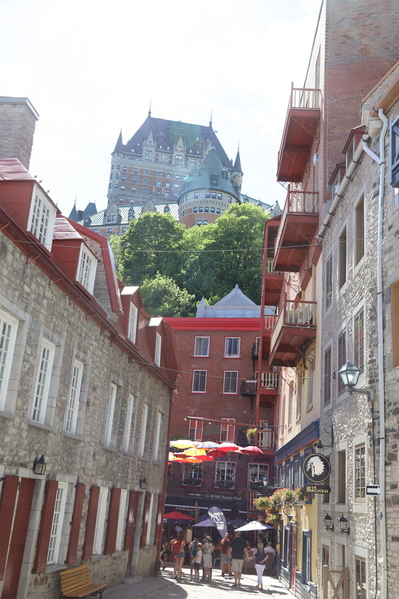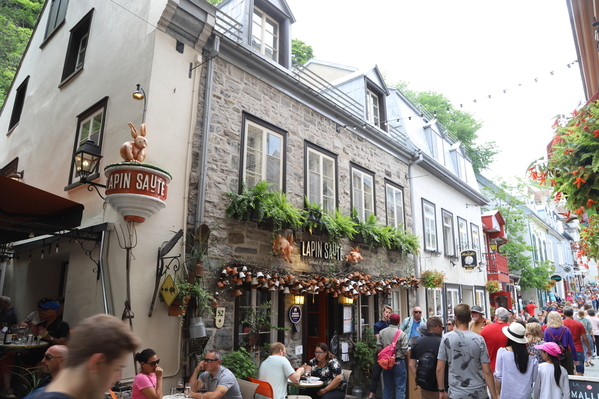Quebec is one of the oldest European-founded cities in North America; only Saint Augustine, Florida (1565) and Jamestown, Virginia (1607) are older. But Quebec, which started as a trading post in 1608, unlike those others uniquely bears the stamp of its origins. It is arguably the most European city in the Americas.
It was founded by famed explorer Samuel de Champlain, who recognized the strategic importance of the site. Quebec was built on a broad rocky promontory (Cap-Diamant) which provided 360 degree defensive views including distant views of the St. Lawrence River valley. The location is at the ”bottleneck” point where the St. Lawrence River expands from one to several miles in width.

Over the years a wall was built to defend the city, the wall still remarkably intact and one of the few found in North America.


Within this fortress lie lovely old stone homes, cathedrals, restaurants and shops that are very reminiscent of Old Europe. It might seem to a visitor that a scoop of 17th century France had been transported to North America — an impression that would generally be correct. Quebec is now a UNESCO World Heritage Site and is a picturesque, charming city well worth visiting and exploring.


Shops and Restaurants along Rue Saint-Louis, Quebec
Our family of four (including two sons in their late teens) stayed in a quaint and comfortable 2 bedroom apartment occupying the second story of an historic home built several centuries ago. It was located in Basseville, the lower portion of the old city, on Le Petit Champlain boulevard, a pedestrian-only walkway filled with quaint shops and restaurants, and lay in the shadow of the grand Chateau Frontenac.

Our apartment was immediately adjacent to the funicular that connects the upper and lower portions of old Quebec. The apartment, accessible only by an external spiral staircase, was very comfortable and provided us with a home-like setting in which to relax and plan our daily walks around the city. The place had a great kitchen/dining area in which we breakfasted on fresh croissants and jam, eggs or cheese, fruit and coffee every morning. It was fun in the evening to sit around our living room and try to understand some of the French TV newscast. The weather was mostly lovely — warm and sunny, with a few days that were cooler and windy and with an occasional rain shower.


Old Quebec is divided into two regions — it’s helpful to you plan your activities by geography. The lower city is Basseville. It encompasses the flat area around the harbor area along the St. Lawrence River. Most of old Quebec (Vieux Quebec) and the majority of the city’s attractions like within the upper walled city on top of Cap-Diamant.

Mural on home in Basseville, Quebec
The upper city is dominated by the castle-like Chateau Frontenac, one of Canada’s historic Canadian Pacific (now Fairmont) hotels, which is the iconic image most people think of when Quebec is mentioned. It sits on Dufferin Terrace, the best place to catch great views of the St. Lawrence valley and to watch ships cruise up and down the River.

The Chateau would be an excellent place to stay during any visit to the city (although its fairly pricey), but there are dozens of nice historic hotels from which to choose. Make sure to at least walk through the lobby of the Chateau to take in some of its historic elegance, and if you can have a snack or meal there. Visit the statue of Champlain beside the funicular on Dufferin Terrace in front of the hotel.

I would recommend spending at least several days exploring the upper city. Stroll the streets and walk around the old stone walls, visit the smallish Notre Dame Basilica and learn about the important role Bishop Laval had in the historic founding of this town. Stroll through the campus and beautiful old buildings of the Seminary of Quebec and Laval University which lie adjacent to the Basilica.
The National Assembly building of Quebec, built in the late 1800s, was the first building to bear what has become Quebec’s slogan: Je Me Souviens, or “I Remember.” There has been controversy over the years about what the architect who chose it meant for the Quebecois to keep in mind.
No visit to Quebec is complete without a stop at the historic Citadel. The Citadel is home to Royal 22nd Regiment, an active unit still engaged in the War on Terror in Afghanistan. If you’re there in summer, schedule your visit so that you can watch the changing of the guard in the morning. This military display is captivating and well worth your time. Take a tour thru the historic fort or of the home of Canada’s Governor General, the Queen’s representative in Canada, which is located inside the thick walls of this fortress.
Immediately adjacent to the Citadel lie the Plains of Abraham, where in 1759 the British (under the leadership of General Wolfe) defeated the French (led by General Montcalm). Thereafter the British governed this island of French culture and heritage until Canadian confederation in 1867, an occupation understandably very irksome to the independent minded French-Canadiens. The Plains of Abraham is now a large urban park and site of celebration of their annual “National Holiday” on June 24th (St. Jean Baptiste Day). We were there during this celebration and can verify that it starts early, runs until dawn, and that the volume of beer consumed is impressive even by Canadian standards – but it was a fun celebration.
There are several excellent day trip opportunities from Quebec City, these generally being located downriver to the east of town. Montmorency Falls, a dramatic and tall waterfall (you’ll hear it endlessly pitched as taller than Niagara Falls), is just off the main highway. It offers a cable car ride to the top of the falls and an assortment of walking and hiking opportunities. Isle De Orleans is an island in the center of the St. Lawrence river — immediately facing Montmorency Falls — which provides much of the summer produce for the region and is a favorite place for locals to go to pick fresh strawberries in the summer and apples in the fall. A bridge connects the island to the northern bank of the St. Lawrence river so access is not a problem. Drive around the island and enjoy the many pretty farms and small towns.

















































Fantastic blog! Quebec City is wonderful. Can’t wait to visit again.
Thank you for this post and the excellent pictures, which reminded me of my visit to Quebec in 2018. I consider it one of the most interesting cities in North America – very French, but yet different from
 anywhere in France itself. The Hotel Frontenac is spectacular from the outside, dominating the views of the lower city – like Dr. Fumblefinger, I found somewhere cheaper to stay.
anywhere in France itself. The Hotel Frontenac is spectacular from the outside, dominating the views of the lower city – like Dr. Fumblefinger, I found somewhere cheaper to stay.
I love Quebec! The province, the City and the Old Quebec At some point in my life, I used to go yearly.
Last time, I visited, was with my youngest son and Travel Rob. We had fun
Did you know that there is a replica of the Chateau Frontenac at Epcot in Florida? I didn’t. It was fun to see.